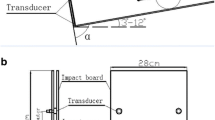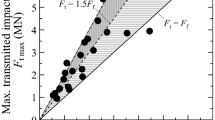Abstract
This paper presents the results of the coefficient of restitution and the kinetic energy loss rate obtained by lab experiment, two parameters that are crucial for rockfall impact. However, various definitions of coefficient of restitution exist and the most appropriate one is still not formed and obtained. In addition, the energy variation during the rockfall impacts has important significance in practical design. In this research, two kind shapes of blocks including plate and strip were adopted in the laboratory testing and the block material was tested before, indicating that the material has sufficient strength to prevent shattering during the impact. Furthermore, an apparatus specifically built for this study was established including a base, a slope and a releasing device. The falling testing was performed using plate and strip block while the falling height as well as the slope angle and releasing height were altered during the tests in order to estimate the effect of each parameter on the coefficients of restitution and energy loss rate. It was observed that collision reflection angle is less than impact angle for all, suggesting energy loss in collision. Impact angle decreases with increasing slope angle while there was no obvious effect of releasing height and releasing angle on impact angle. The relevant coefficient of restitution was found to decrease with impact angle, and the kinetic energy loss rate increased. Finally, the kinetic energy before and after the impact was found to significantly affect the COR and energy loss rate and the results can provide basis for mitigation measures.
Similar content being viewed by others
References
Agliardi, F. and Crosta, G. B. (2003). “High resolution three-dimensional numerical modelling of rockfalls.” International Journal of Rock Mechanics and Mining Sciences, Vol. 40, No. 4, pp. 455–471, DOI: 10.1016/S1365-1609(03)00021-2.
Alejano, L. R., Pons, B., Bastante, F. G., Alonso, E., and Stockhausen, H. W. (2007). “Slope geometry design as a means for controlling rockfalls in quarries.” International Journal of Rock Mechanics and Mining Sciences, Vol. 44, No. 6, pp. 903–921, DOI: 10.1016/j.ijrmms.2007.02.001.
Asteriou, P., Saroglou, H., and Tsiambaos, G. (2012). “Geotechnical and kinematic parameters affecting the coefficients of restitution for rock fall analysis.” International Journal of Rock Mechanics and Mining Sciences, Vol 54, pp. 103–113, DOI: 10.1016/j.ijrmms.2012.05.029.
Azzoni, A. and De Freitas, M. H. (1995). “Experimentally gained parameters, decisive for rock fall analysis.” Rock Mechanics and Rock Engineering, Vol. 28, No. 2, pp. 111–124, DOI: 10.1007/BF01020064.
Azzoni, A., La Barbera, G., and Zaninetti, A. (1995). “Analysis and prediction of rockfalls using a mathematical model.” International Journal of Rock Mechanics and Mining Sciences, Vol. 32, No. 7, pp. 709–724, DOI: 10.1016/0148-9062(95)00018-C.
Bozzolo, D. and Pamini, R. (1986). “Simulation of rock falls down a valley side.” Acta Mech, Vol. 63, pp. 113–130, DOI: 10.1007/BF01182543.
Buzzi, O., Giacomini, A., and Spadari, M. (2012). “Laboratory investigation on high values of restitution coefficients.” Rock Mechanics and Rock Engineering, Vol. 45, No. 1, pp. 35–43, DOI: 10.1007/s00603-011-0183-0.
Cazzani, A., Mongiov, L., and Frenez, T. (2002). “Dynamic finite element analysis of interceptive devices for falling rocks.” International Journal of Rock Mechanics and Mining Sciences, Vol. 39, No. 3, pp. 303–321, DOI: 10.1016/S1365-1609(02)00037-0.
Chau, K. T., Wong, R. H. C., and Wu, J. J. (2002). “Coefficient of restitution and rotational motions of rockfall impacts.” International Journal of Rock Mechanics and Mining Sciences, Vol. 39, No. 1, pp. 69–77, DOI: 10.1016/S1365-1609(02)00016-3.
Chau, K. T., Wong, R. H. C., Liu, J., Wu, J. J., and Lee, C. F. (1999). Shape effects on the coefficient of restitution during rockfall impacts, In 9th ISRM Congress., International Society for Rock Mechanics, Paris. pp. 541–544.
Descoeudres, F. and Zimmermann, T. H. (1987). Three-dimensional dynamic calculation of rockfalls, In 6th ISRM Congress., International Society for Rock Mechanics, Montreal.
Gentilini, C., Gottardi, G., Govoni, L., Mentani, A., and Ubertini, F. (2013). “Design of falling rock protection barriers using numerical models.” Engineering Structures, Vol. 50, pp. 96–106, DOI: 10.1016/j.engstruct.2012.07.008.
Guzzetti, F., Crosta, G., Detti, R., and Agliardi, F. (2002). “STONE: A computer program for the three-dimensional simulation of rockfalls.” Computers & Geosciences, Vol. 28, No. 9, pp. 1079–1093, DOI: 10.1016/S0098-3004(02) 00025-0.
Huang, R. Q., Liu, W. H., Zhou, J. P., and Pei, X. J. (2007). “Rolling tests on movement characteristics of rock blocks.” Chinese Journal of Geotechnical Engineering, Vol. 29, No. 9, pp. 1296–1302, DOI: 10.3321/j.issn:1000-4548.2007.09.003.
Japan-Road-Association. (1983). Rockfall Handbook, Tokyo.
Pantelidis, L. (2009). “Rock slope stability assessment through rock mass classification systems.” International Journal of Rock Mechanics and Mining Sciences, Vol. 46, No. 2, pp. 315–325, DOI: 10.1016/j.ijrmms.2008.06.003.
Pantelidis, L. (2010). “An alternative rock mass classification system for rock slopes.” Bulletin of engineering geology and the environment, Vol. 69, No. 1, pp. 29–39, DOI: 10.1007/s10064-009-0241-y.
Paronuzzi, P. (1989). “Probabilistic approach for design optimization of rockfall protective barriers.” Quarterly Journal of Engineering Geology and Hydrogeology, Vol. 22, No. 3, pp. 175–183, DOI: 10.1144/GSL.QJEG. 1989.022.03.02.
Pfeiffer, T. and Bowen, T. (1989) Computer simulation of rock falls. Bull Assoc Eng Geol, Vol. 26, pp. 135–146.
Spang, R. M. and Rautenstrauch, R. W. (1988). “Empirical and mathematical approaches to rockfall protection and their practical applications.” In Proc. 5th Int. Symp., Landslides, Lausanne, pp. 1237–1243.
Spang, R. M., and Sonser, T. (1995). Optimized rockfall protection by ‘ROCKFALL’, In 8th ISRM Congress. International Society for Rock Mechanics.
Stevens. W. (1998) “Rocfall: A tool for probabilistic analysis, design of remedial measures and prediction of rock falls.” Master’s thesis, Department of Civil Engineering, University of Toronto. Ontario.
Author information
Authors and Affiliations
Corresponding author
Rights and permissions
About this article
Cite this article
Li, Lp., Sun, Sq., Li, Sc. et al. Coefficient of restitution and kinetic energy loss of rockfall impacts. KSCE J Civ Eng 20, 2297–2307 (2016). https://doi.org/10.1007/s12205-015-0221-7
Received:
Revised:
Accepted:
Published:
Issue Date:
DOI: https://doi.org/10.1007/s12205-015-0221-7




